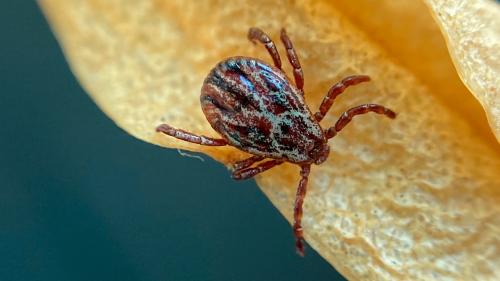New villain enters Danish nature

An increasing number of Danish ticks are now carrying the TBE virus, which can cause Central European encephalitis in humans. TBE is a known problem in Swedish and Norwegian forests, and it is now on the rise in Denmark. But new concerns for nature-loving Danes are also coming from the south.
The citizen participation research project fl?tinfo.dk has now received their first registration of a meadow tick.
"The meadow tick, which was found on a dog, is a rare find in Denmark. 兴发娱乐官网手机版客户端 would therefore like to thank the citizen for the discovery and encourage anyone who comes across a different-looking tick to register and submit it," says Karen Angeliki Krogfelt, Professor (MSO) in Molecular and Medicinal Biology and one of three researchers working on the project.
Black wounds and blood parasites
The meadow tick is and looks quite different from the common tick. First of all, it doesn't have the same black and maroon body, but is instead brown with light-coloured markings running across it.
In addition, as its name suggests, it lives not only in forests and tall, dense vegetation, but also in open terrain.
Most important to note, however, is the range of new infections that the meadow tick can carry. The bacterium Rickettsia raoultii can cause skin infections and black sores on the area where you were bitten because the tissue dies. In rare cases, it attacks the lymphatic system and can make people seriously ill.
Sometimes the meadow tick also carries the blood parasite Babesia canis, which, while not dangerous to humans, can cause a malaria-like disease in dogs. They need urgent treatment if they are bitten and get the parasite inside their body.
Established or not
The dog that provided the researchers behind fl?tinfo.dk with their first recorded meadow tick has picked it up either north or west of Copenhagen.
The dog may have picked up the tick in Geel Skov near Holte, in Vestskoven near Albertslund or in a residential neighbourhood in Glostrup, according to the research trio, which in addition to Karen Angeliki Krogfeldt includes PhD student Mette Frimodt Hansen and academic assistant Camilla Adler S?rensen.
However, it is difficult to determine at this point whether there is a larger population in that particular area.
No one has yet managed to find a specimen of the meadow tick in the wild, only on game and on dogs. This makes it difficult to determine if the meadow tick has actually established itself in Denmark and how widespread it is.
That's why Danish registrations are so important. If dog owners check their dogs or hunters check their prey thoroughly for specific ticks, they give researchers a chance to determine exactly how widespread the meadow tick really is.
"It is important to register the ticks so that we know how many there are and where in Denmark they are located. But it is also important that Danes take pictures and send us the ticks so that we can detect when there are types of ticks present other than the common tick," says Mette Frimodt Hansen.
Facts about fl?tinfo.dk
At fl?tinfo.dk, Danes can register where they see and are bitten by ticks. They can also note if the bite made them or their dog sick and they can get help sending the tick to the researchers.
The website is the centrepiece of a research project that plans to map ticks in Denmark.
It is a so-called citizen science project, where the general population plays a key role in collecting data that is then used in the research.
Professor (MSO) of Molecular and Medicinal Biology Karen Angeliki Krogfelt, PhD student Mette Frimodt Hansen and academic assistant Camilla Adler S?rensen are behind the project.